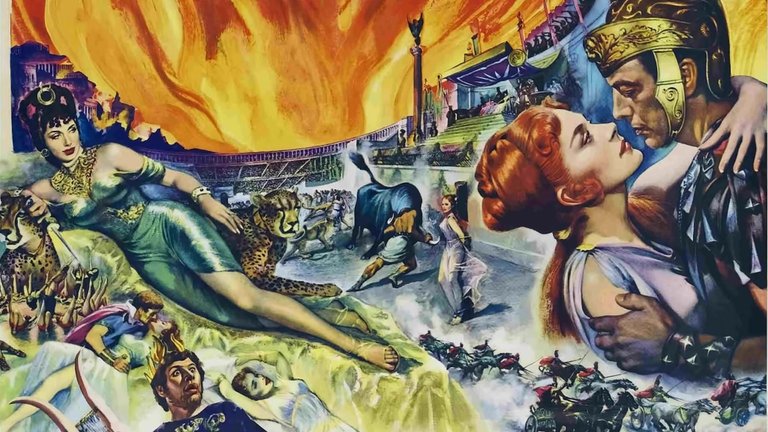Film Review: Quo Vadis (1951)

Success in Hollywood is very fleeting. In early 1950s, during what many considered to be Hollywood’s golden age, MGM, its most powerful and celebrated studio, which was delivering series of popular and spectacular musicals, was actually at the verge of bankruptcy. Something very special was necessary for such fate to be avoided and that proved to be Quo Vadis, 1951 biblical epic directed by Mervyn Le Roy, known as one of the most colossal, but also one of the most successful films of its time, that would later launch trend of “larger-than-life” biblical and historical epics.
The film is based on eponymous 1896 novel by Polish writer Henryk Sienkiewicz that has been adapted for four previous screen adaptations. The plot begins in Rome in 64 AD, when the Roman Empire is ruling most of the known world. Marcus Vicinius (played by Rod Taylor) is commander of 14th Legion which has spent three years fighting against Britons and which is to take part in grand triumphal procession. Vicinius’ uncle Petronius (played by Leo Genn) is member of inner circle at the court of Nero (played by Peter Ustinov), young, spoiled, pompous and tyrannical emperor. Vicinius can expect many lucrative posts and similar rewards for his military victories, but instead of that he asks Nero to give him Lygia (played by Deborah Kerr), beautiful barbarian princess that had been given as hostage to Rome. He had seen and fallen in love with her while visiting a distinguished general Aulus Plautius (played by Felix Aylmer) who became Lygia’s adopted father. Vicinius soon learns that Lygia, Plautius, his wife Pomponia Graecina (played by Nora Swinburn) are members of the new sect known as “Christians”. Although at first sceptical towards new faith, whose peace-loving teachings seem so alien to traditional Roman virtues, his love to Lygia, especially after it is requited, makes him sympathetic to her cause. At the same time, power-mad Nero gets an insane idea to replace Rome with a new city that should be built from scratch and decides to start massive fire. When people react angrily, he decides to find convenient scapegoat in Christians who are arrested and brought to arena where they would be put to death in the most cruel ways.
MGM has obtained rights to sound film adaptation of the novel by Sienkiewicz’s heirs more than decade before. Enormous logistical and technical demands, as well as ensuing Second World War, prevented Quo Vadis to be put in production until early 1950s. It was nevertheless a very ambitious project and, even with the relative cheap labour force and facilities of famous Cinecitta studios in Rome, the budget rose to more than 7 million US$, making the film the most expensive in Hollywood’s history by that time. Producer Sam Zimbalist, on the other hand, could have expected built-in audience for a film based on popular novel and with explicitly Christian stance. Main attraction was, however, spectacle provided by massive sets and scenes featuring tens of thousands of extras. Mervyn Le Roy, one of the most experienced and versatile directors of Classic Hollywood, handled large resources well and created number of well-made scenes, most notably those depicting decadent life in Nero’s palace and the Christians being thrown to the lions in arena. Spectacle was even better thanks to lush Technicolor which was by that time becoming standard for such sort of films. Widescreen format provided by Cinemascope only two years later soon made Quo Vadis look dated, but that didn’t happen before scoring more than 21 million US$ at box office and becoming the biggest hit since Gone with the Wind.
However, once the viewer gets accustomed to such spectacle, some serious flaws of Quo Vadis become apparent. Some of them could be attributed to literary source, which uses too much melodrama and not always balanced mix of real history, apocryphal biblical stories and fiction. Dialogues at times look stale and preachy. Viewers who aren’t devout Christians might find some segments of the plot, at least that don’t deal with Nero and his lunacy, a little boring. Soundtrack by Miklos Rozsa, while serviceable, isn’t particularly memorable or inspiring. But the worst flaw of Quo Vadis is miscasting of Robert Taylor and Deborah Kerr, talented actors who lack mutual chemistry and whose characters, although nominal protagonists, look bland. It’s quite another story with Leo Genn as Petronius, character who tries and tragically fails to serve as Nero’s voice of reason, ultimately becoming one of the most sympathetic figures in the story. But the best performance belongs to young Peter Ustinov, who, apparently left to improvise by Le Roy, marvels at opportunity to portray infamous monarch with great energy and ingenuity. Ustinov earned Golden Globe for Best Supporting Actor for his efforts, and he would later win Oscar by appearing in similarly-themed Spartacus. Quo Vadis received six Oscar nominations but received none. This surprising snub is actually quite deserving for today’s perspective, but Le Roy’s film nevertheless served its purpose not only by rescuing major Hollywood studios but also serving as inspirations for other “larger-than-life” historical epics that would become the norm in Hollywood in next two decades.
RATING: 6/10 (++)
Blog in Croatian https://draxblog.com
Blog in English https://draxreview.wordpress.com/
InLeo blog https://inleo.io/@drax.leo
InLeo: https://inleo.io/signup?referral=drax.leo
Unstoppable Domains: https://unstoppabledomains.com/?ref=3fc23fRc42c1b417
Hiveonboard: https://hiveonboard.com?ref=drax y
Bitcoin Lightning HIVE donations: https://v4v.app/v1/lnurlp/qrcode/drax
Rising Star game: https://www.risingstargame.com?referrer=drax
1Inch: https://1inch.exchange/#/r/0x83823d8CCB74F828148258BB4457642124b1328e
BTC donations: 1EWxiMiP6iiG9rger3NuUSd6HByaxQWafG
ETH donations: 0xB305F144323b99e6f8b1d66f5D7DE78B498C32A7
Posted using CineTV